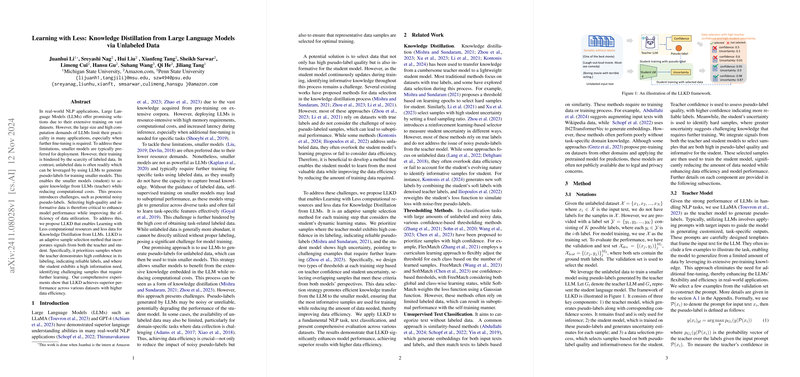An Analysis of "Learning with Less: Knowledge Distillation from LLMs via Unlabeled Data"
The paper "Learning with Less: Knowledge Distillation from LLMs via Unlabeled Data" addresses the computational challenges posed by LLMs and proposes a framework for knowledge distillation (KD) that leverages unlabeled data. This approach enables smaller, more efficient models to inherit the capabilities of LLMs without the prohibitive resource requirements typically associated with LLM deployment. The authors propose a novel system called LLKD (Learning with Less for Knowledge Distillation), which employs adaptive sample selection mechanisms to improve data efficiency and computational resource utilization.
Methodology
The LLKD framework is built on a teacher-student paradigm where the teacher is a pre-trained LLM and the student is a smaller, task-specific model. Key to this approach is the use of pseudo-labels generated by the teacher model from abundant unlabeled data. The main challenge with this method lies in the potential noisiness of these pseudo-labels. The authors tackle this problem by developing an adaptive sample selection strategy that prioritizes samples showing high teacher confidence and high student uncertainty.
For measuring the quality of pseudo-labels, the proposed method considers the teacher's confidence in its predictions. The data considered most informative for the student's learning process are those with high uncertainty from the student model's perspective. These dual conditions create a dynamic thresholding technique, implemented at each training step based on both teacher and student models' predictions, that enables the selection of samples beneficial for robust model training.
Empirical Results
The authors validate their approach through extensive experiments on five datasets across various domains including medical abstracts, social media data, and professional biographies. The results indicate that LLKD consistently outperforms traditional KD methods as well as recent semi-supervised learning techniques. Notably, LLKD achieves superior accuracy and macro-F1 scores with significantly reduced training data. For instance, on the PubMed-RCT-20k dataset, the LLKD framework achieves a substantial improvement in macro-F1 score while requiring only 3.7% of the training data compared to baseline methods, demonstrating remarkable data efficiency without sacrificing performance.
Discussion and Implications
The research presented showcases the potential of a refined KD process that leverages the abundant availability of unlabeled data, addressing both practical deployment challenges and theoretical advancements in the efficiency of model training. The implications extend beyond just reducing computational resource demands; they suggest pathways for the broader application of LLMs in low-resource environments and scenarios where labeled data are scarce.
From a theoretical perspective, this framework adds to the understanding of how knowledge can be effectively distilled from an LLM to a smaller model. The integration of confidence from the teacher and uncertainty from the student into the sample selection process is a strategic advancement that can be extended to other domains of machine learning and distillation scenarios.
Future Directions
Future research may explore the generalizability of LLKD across different types and architectures of LLMs, as well as its applicability to other machine learning tasks such as generation or reinforcement learning. Moreover, investigating the impact of varying the size and training settings of both the teacher and student models could yield insights into the dynamics of knowledge transfer within this framework.
Overall, the paper contributes significantly to the evolving landscape of knowledge distillation by providing an innovative approach to efficiently leverage LLMs, ultimately improving access to advanced NLP capabilities in diverse applications. The framework appears robust and adaptable, making it an intriguing candidate for further exploration in both academic research and real-world applications.
